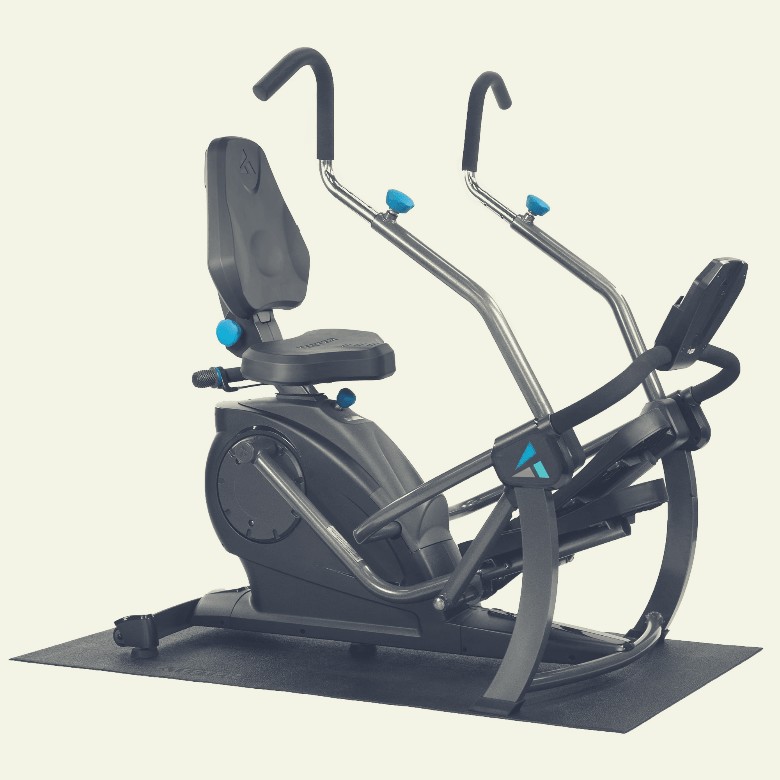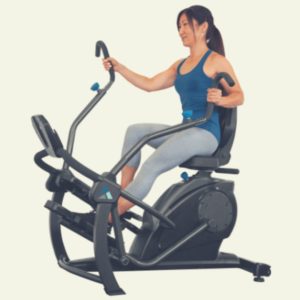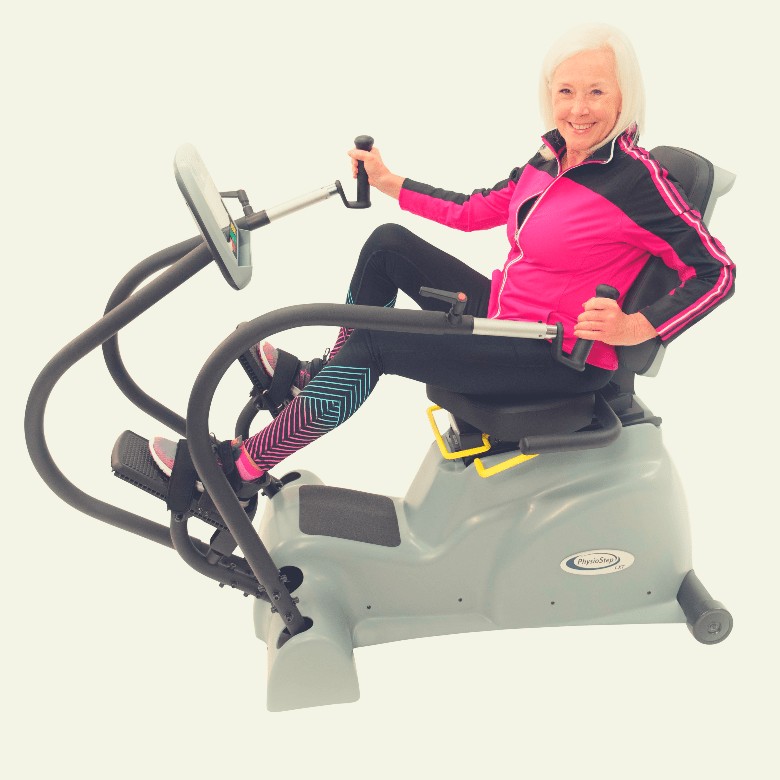In the 21st-century, the options for exercise are many. You can exercise in a gym, outside, or at home.
You can exercise on a machine, use free weights, run outside, and more.
The exercise I’ve found that works best for me is using a recumbent cross trainer, such as the Teeter FreeStep LT3 Recumbent Cross Trainer vs. HCI Fitness PhysioStep LXT-700.
I can get a full-body workout on a recumbent cross trainer because it gives me a cardio workout and works my legs and arms.
However, and most importantly, I can get a full-body workout with less chance of injury.
In this article, I’ll explain what recumbent cross trainers are; I’ll explain why cardio and strength training is important.
Then, I’ll review and compare the Teeter FreeStep LT3 Recumbent Cross Trainer vs. HCI Fitness PhysioStep LXT-700.
What Is a Recumbent Cross Trainer?
I’ve always been active in my life, but now I’ve gotten older. What can you face as you get more senior in life?
One of the things you may face is back pain or joint pain. This kind of pain has happened to me even when I’m not working out.
Another thing I’ve noticed in life is that when I was younger, I could exercise hard with a relatively easy recovery.
However, the older I get, the harder the recovery and the more susceptible I am to injuries.
I knew I needed to find an answer to my physical issues. That’s why I’m so glad I learned about recumbent cross trainers.
Recumbent cross trainers are unique. So to describe them, I’ll need to break it down:
Elliptical Machine
The exercise machine known as an elliptical trainer is a low-impact stationary exercise machine used to perform a climbing like motion.
It is less stressful on the hips, back, and knees than a treadmill.
As you move the pedals in a climbing motion, many ellipticals also have arm handles allowing you to move your arms back and forth, as if you were using ski poles, for example.
Ellipticals enable you to move the pedals forward or backward.
Recumbent Bike
A recumbent bike is similar to a traditional upright stationary bike. Both bikes give you a workout without hurting your knees and other joints.
However, a recumbent bike is set up differently from a stationary bike.
A stationary bike has its seat situated like a regular bike. A recumbent bike’s seat is located so that your legs are extended in front of you as you pedal.
This gives you less back strain, a problem I’ve had after some workouts. I can get on and off a recumbent bike easier, too.
Recumbent Cross Trainer
A recumbent cross trainer is a combination of an elliptical trainer and a recumbent bike. The seat of a recumbent cross trainer is similar to the recumbent bike, but the pedaling is different.
You push the pedals back and forth with your feet. Recumbent cross trainers also have handles to exercise your arms.
A Word About Cardio and Strength Training
As I mentioned earlier, with recumbent cross trainers, I can strengthen my legs and arms and contribute to my cardiovascular health. It’s been shown that both kinds of exercise are important, especially for someone my age.
Fitness is about balance, and that means that just doing strength training or just doing cardio is not the best way to approach exercise.
It would be best if you strived to include both, along with a balanced diet.
Cardio, such as swimming, walking, running, or working on a recumbent cross trainer, makes your heart beat faster, which increases your blood flow to your muscles and lungs.
Your muscles, therefore, receive more oxygen and eliminate more waste, such as carbon dioxide.
Engaging in cardio helps you maintain your health and a healthy weight.
Strength training, such as lifting weight, bodyweight exercises, or resistance achieved from a recumbent cross trainer, helps strengthen your muscles and make them more efficient.
Strength training leads to strong bones that can reduce the risk of osteoporosis, which, for me, as a woman, is a concern as I grow older.
Teeter FreeStep LT3 vs. HCI Fitness PhysioStep LXT
In the past, it was typical to find recumbent cross trainers only at professional physical therapy locations.
However, today, you can purchase one for use in your home.
This is excellent for someone like me who has experienced joint and back issues because I don’t have to leave my house to get a good cardio and strength training workout.
Now let’s move on to the Teeter FreeStep LT3 Recumbent Cross Trainer vs. HCI Fitness PhysioStep LXT-700. I’ll examine the two machines, do a comparison table, and conclude with closing comments.
Teeter FreeStep LT3 Recumbent Cross Trainer
Teeter, a family-run business founded by Roger Teeter in 1981, produces the Teeter FreeStep LT3 Recumbent Cross Trainer, which is an upgrade over the FreeStep LT1. I’ll explain the upgrades later.
The machine, tested over 2.5 million cycles for customer useability, is designed to protect the knees, the hips, and the back while protecting the muscles, strengthening the muscles, and getting a cardio workout.
When using the machine, the user experiences no clicks, jolts, or pops, typical with some elliptical machines. Therefore, the motion is smooth.
This is achieved through Teeter’s FreeStep unique “Stride Technology.”
The technology is designed to protect the knees and keeps the knees from traveling over the toes while stabilizing the hips and back.
Teeter FreeStep LT3 Recumbent Cross Trainer Highlights
Users can benefit from premium upgrades with the Teeter FreeStep LT3 Recumbent Cross Trainer:
- Teeter’s “ComfortSelect” seat is 27 percent thicker and features a 12 percent increase in the surface area.
- Teeter’s “SoftStep” pedals provide better comfort and traction.
- Teeter’s “SureGrip” handles offer better grip and durability, provide rotating handle settings for targeting different muscle groups, are sweat-resistance, and are easier to clean.
- Teeter’s “UltraGlide” bearings are commercial-grade steel as opposed to plastic.
Although the Teeter FreeStep LT3 Recumbent Cross Trainer is ideal for a workout with no stress, if you want to work your legs hard, work your arms hard, or both, it can be done, and still with less stress.
The machine allows you to vary the intensity from lower to higher and adjust the handle to target different muscle groups.
The machine’s push-pull mechanics offer a total body workout that will result in your continuing to burn fat after the training.
The Teeter FreeStep LT3 Recumbent Cross Trainer burns 17.4 percent more calories per hour than a recumbent bike.
Other features of the Teeter FreeStep LT3 Recumbent Cross Trainer is smart technology in the form of a digital console.
This is where you can listen to music or read from your device, all while keeping track of your distance, time, speed, and calorie-burn.
The machine includes a water bottle holder as well as wheels for easy transport and storage.
A heavy-duty mat is available for separate purchase to protect your floor and keep dust and debris from gathering around the machine.
Pros
- The FreeStep LT3 is designed to protect the knees, the hips, and the back while protecting the muscles, strengthening the muscles, and getting a cardio workout.
- The machine has a smooth motion achieved through Teeter’s “Stride Technology.”
- The recumbent cross trainer allows you to vary the intensity from lower to higher and adjust the handle to target different muscle groups.
- The machine includes a digital console with smart technology.
- The machine includes a water bottle holder.
- Users can purchase a heavy-duty mat to protect the machine.
- The machine includes premium upgrades, including “ComfortSelect” sets, “SoftStep” pedals, “SureGrip” handles, and “UltraGlide” bearings.
- The machine is much cheaper than the HCI Fitness PhysioStep LXT.
Cons
- The machine is affordable, but that also makes it a basic machine, not a luxury machine.

>> Check out our full review of the Teeter Freestep LT3 here < <
HCI Fitness PhysioStep LXT
Family owned and operated since 1992, HealthCare International, also known as HCI, produces the PhysioStep LXT.
This recumbent cross trainer is designed for wellness, weight loss, cardiac rehabilitation, and going from physical therapy to home exercise.
The HCI Fitness PhysioStep LXT-700 is a low-impact machine that features an ergonomic design exclusive to HCI.
The design was created to accommodate a wide variety of fitness levels and give users a total body workout. It also has 32 levels of resistance to choose from.
The machine features an exclusive, patented, low-impact linear stepping motion. The transition platform lets you easily put your feet in and out of the pedals.
The seat features an oversized 20 inches 360-degree swivel seat with orthopedic foam and lumbar support.
In addition, the seat slides and the recline can be adjusted for users from 4′ 6″ to 6’4″ and up to 400 pounds.
The machine’s seat handles provide for choosing your hand position to target specific muscles and measure your heart rate.
The HCI Fitness PhysioStep LXT-700 features a large 9-inch color-coded display designed to be easy-to-read- and designed to motivate and track progress.
Users can press “quick start” to start a workout or choose from 19 workout programs.
The machine is designed to be compact enough to fit comfortably into your home. It has rear roller wheels that make it easy to move and store.
Pros
- The HCI Fitness PhysioStep LXT-700 is designed for wellness, weight loss, cardiac rehabilitation, and going from physical therapy to home exercise.
- The machine features an ergonomic design.
- There are 32 levels of resistance.
- The HCI Fitness PhysioStep LXT-700 has an exclusive, patented, low-impact linear stepping motion.
- The user can easily slip feet in and out of the pedals.
- The machine’s seat is an oversized 20 inches, is made with orthopedic foam, has lumbar support, slides and reclines, and can be adjusted for users from 4′ 6″ to 6’4″ and up to 400 pounds.
- The user can adjust the hand positioning to target specific muscles and to measure heart rate.
- The HCI Fitness PhysioStep LXT-700 has a 9-inch color-coded display for easy ready. It features a “quick start,” or the user can choose from 19 workout programs.
- The machine is compact to fit in a variety of home settings.
- The machine has rear roller wheels for easy moving and storage.
Cons
- The HCI Fitness PhysioStep LXT-700 is much more expensive than the Teeter FreeStep LT3.

Comparison Table
| Teeter FreeStep LT3 | HCI Fitness PhysioStep LXT | |
| Gentle to Joints | YES | YES |
| Smooth Motion | YES | YES |
| Adjust for intensity and targeting muscle groups | YES | YES |
| Digital console | YES | YES |
| Water bottle holder | YES | NO |
| Option to purchase mat | YES | NO |
| Inexpensive | YES | NO |
| 32 Levels of Resistance | NO | YES |
| Ergonomic design | YES | YES |
| Comfort seat | YES | YES |
| Easy to move and store | YES | YES |
Final Thoughts
Whether you choose Teeter FreeStep LT3 Recumbent Cross Trainer vs. HCI Fitness PhysioStep LXT-700, both recumbent cross trainers are a way for you to strengthen your body, get a cardio workout, and do so in a gentle manner.
Using a machine like this becomes important if you are experiencing joint or back pain or finding it harder to recover after a workout.







